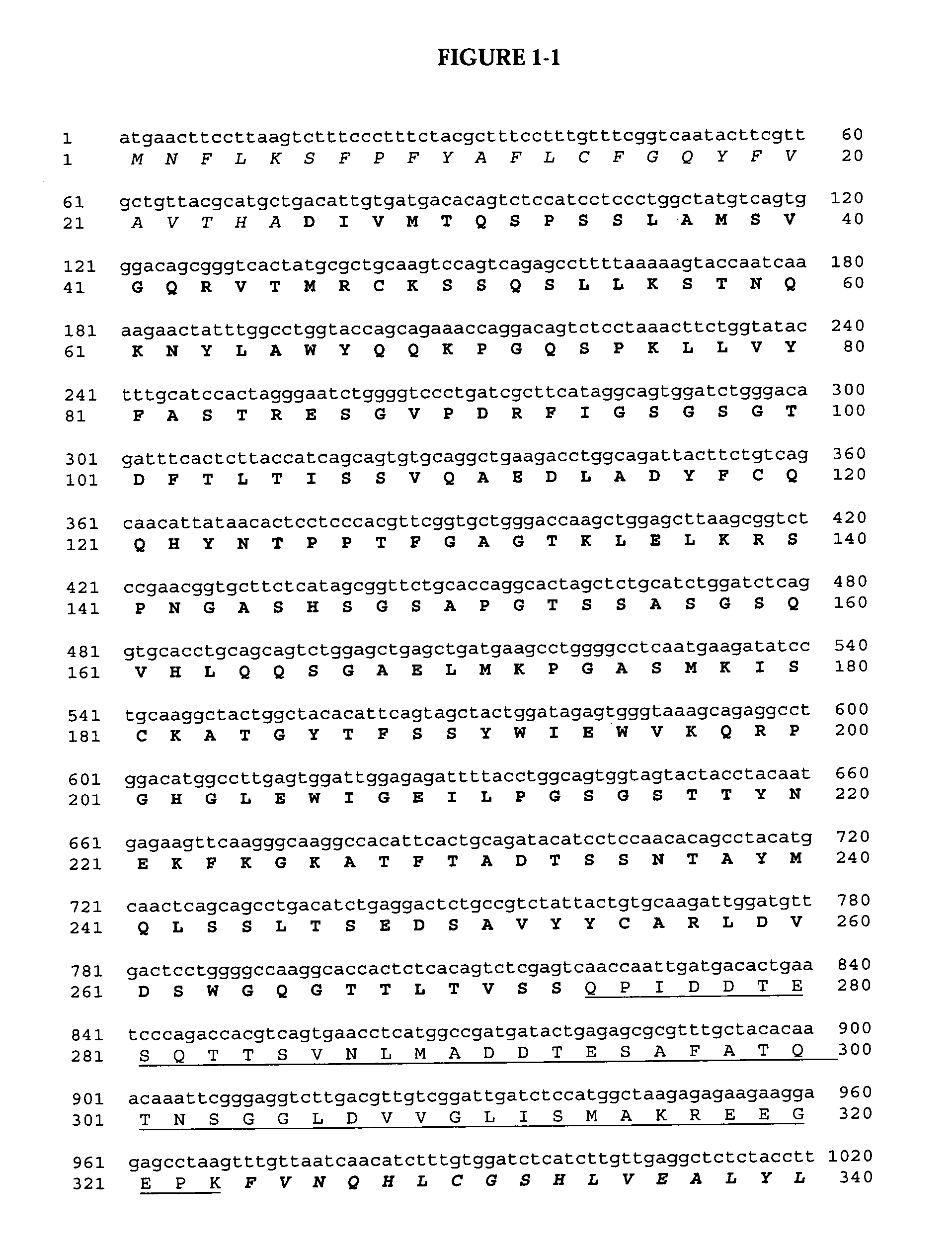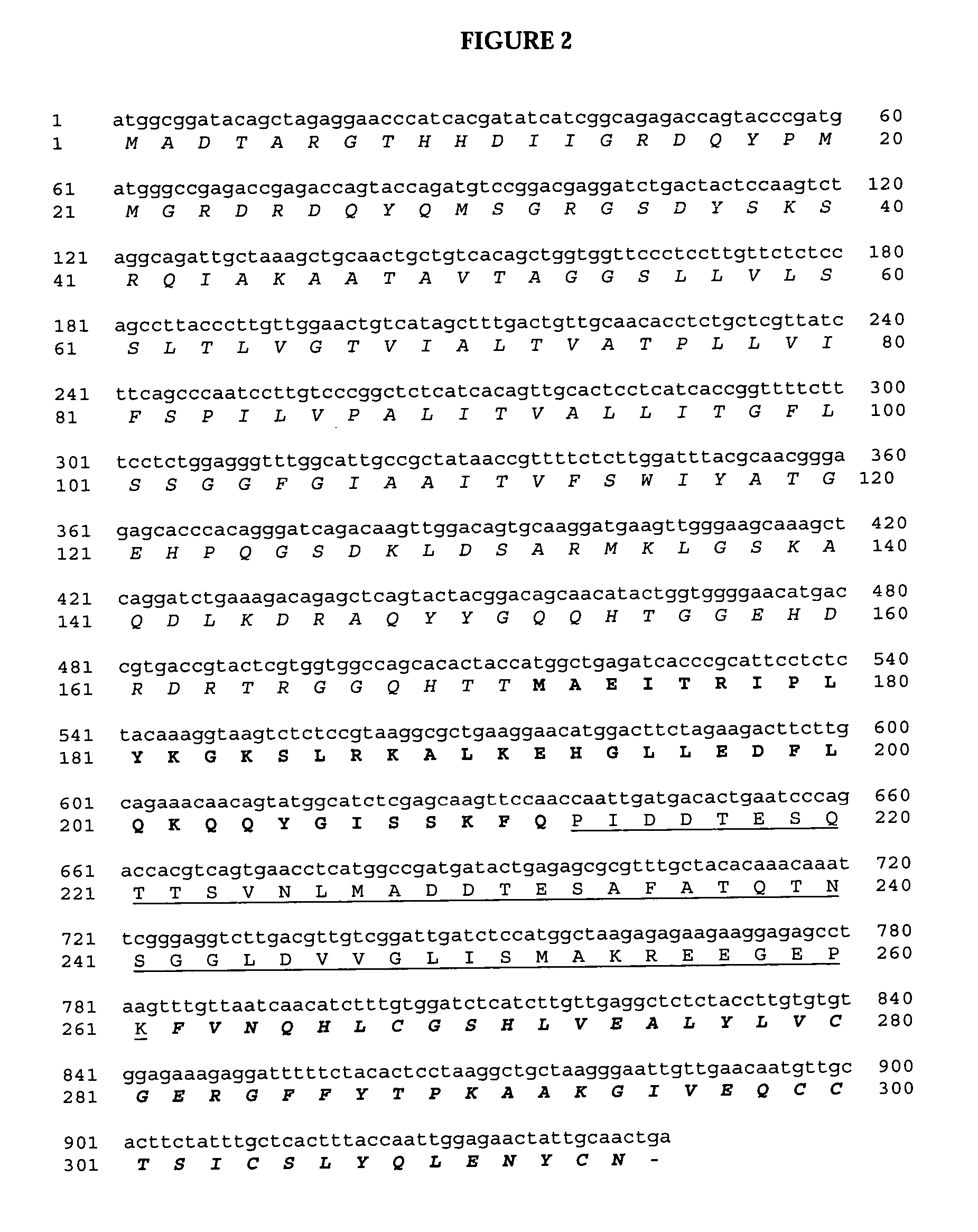Methods for the production of insulin in plants
a technology of plant genetic engineering and production methods, applied in the field of plant genetic engineering methods and to the production of insulin, can solve the problems of unfavorable production economics, lower yields and higher costs than desired, and high cost of methods,
- Summary
- Abstract
- Description
- Claims
- Application Information
AI Technical Summary
Benefits of technology
Problems solved by technology
Method used
Image
Examples
example 1
Preparation of an Insulin Protein Expressed as a Mini-insulin (MI) Fusion Protein with a Trypsin Cleavable Pro-peptide
Construction of pSBS4404: PRS-D9scFv-Klip27-MI-KDEL Fusion Protein
[0172]One of the fusion proteins studied began with the tobacco pathogen related sequence (PRS) (Sijmons et al., 1990, Bio / technology, 8:217-221) which served as the signal peptide to target expression to the ER in a co-translational manner. Immediately downstream was a sequence encoding for a single-chain Fv antibody (scFv) with species-specific affinity against the 18 kDa oleosin from Arabidopsis thaliana denoted D9scFv, followed by a trypsin cleavable pro-peptide (KLIP27) derived from the TA57 pro-peptide of yeast (Kjeldsen et al., 2001, Biotechnology and Genetic Engineering Reviews 18:89-121). This was followed by mini-insulin (MI) described by Kjeldsen et al. (2001) with the addition of a KDEL ER-retention signal at the C-terminal end of the polypeptide.
[0173]The backbone of this plasmid, pSBS4055...
example 2
Expression Levels of Insulin in Arabidopsis thaliana
[0183]In the second example, expression levels of the fusion protein D9scfv-KLIP27-MI-KDEL (4404), OLEO-KLIP8-KLIP27-MI (4405) and PRS-MI-RRKR-D9Scfv-KDEL (4414) were determined in transgenic Arabidopsis thaliana mature seed. The transgene product was shown to be present in the cellular extracts of mature seed. Approximately 40 transgenic Arabidopsis thaliana seeds were ground with a mortar and pestle in 50 μl of 50 mM Tris-HCl pH 8.0. Then, a reducing SDS-PAGE sample buffer (6×SDS sample buffer, 0.35 M Tris-HCl pH 6.8, 30% glycerol, 10% SDS, 0.012% bromophenol blue, 5% β-mercaptoethanol) was added to the slurry and mixed by briefly vortexing. The sample was then briefly centrifuged and placed at 99° C. for 10 minutes. After cooling on ice for 2 minutes the sample was centrifuged briefly. Samples were loaded (10 μl—equivalent to approximately 7 seeds) under reducing conditions.
[0184]For oil body prepared samples the transgenic and...
example 3
Cleavage of pSBS4404 and HPLC Purification
[0186]In the third example, 1 g of transgenic seed was homogenized in 12 ml extraction buffer (0.4 M sucrose, 0.5 M NaCl, 50 mM Tris-HCl pH 8.0) and centrifuged at 10 000 g for 10 min, the fat pads were removed and placed in 1 ml of 20 mM Na2HPO4, 0.5 M NaCl and re-centrifuged as above. This was repeated twice, before washing and centrifuging the fat pad twice in 750 μl 20 mM Na2HPO4. The 4404 fusion protein was eluted from the oil body into the undernatant by washing the final fat pad 5 times in 750 μl 20 mM formic acid pH 4.1, with 10 000 g centrifugation steps in between each wash. The collected elution fractions (undernatants) were pooled and neutralized with 2 N NaOH to pH 8.0. The entire solution was then placed at −80° C. to freeze, and lyophilized overnight to concentrate the fusion protein. The lyophilized sample was re-suspended in 500 μl 50 mM Tris-HCl pH 8.0. The resuspended 4404 fusion protein was then desal...
PUM
| Property | Measurement | Unit |
|---|---|---|
| Fraction | aaaaa | aaaaa |
| Solubility (ppm) | aaaaa | aaaaa |
| Solubility (ppm) | aaaaa | aaaaa |
Abstract
Description
Claims
Application Information
 Login to View More
Login to View More - R&D
- Intellectual Property
- Life Sciences
- Materials
- Tech Scout
- Unparalleled Data Quality
- Higher Quality Content
- 60% Fewer Hallucinations
Browse by: Latest US Patents, China's latest patents, Technical Efficacy Thesaurus, Application Domain, Technology Topic, Popular Technical Reports.
© 2025 PatSnap. All rights reserved.Legal|Privacy policy|Modern Slavery Act Transparency Statement|Sitemap|About US| Contact US: help@patsnap.com



